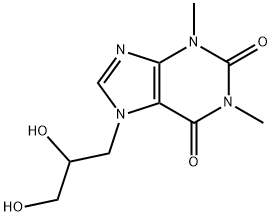| Identification | More | [Name]
Diprophylline | [CAS]
479-18-5 | [Synonyms]
7-(2,3-dihydroxypropyl)-1,3-dimethyl-purine-2,6-dione
7-(2,3-DIHYDROXYPROPYL)THEOPHYLLINE
7-(BETA,GAMMA-DIHYDROXYPROPYL)-THEOPHYLLINE
7-DIHYDROXYPROPYLTHEOPHYLLINE
DIPHYLLIN
DIPROPHYLLIN
DIPROPHYLLINE
DIPROPYHYLLIN
DYPHYLLINE
LUFYLLIN
TIMTEC-BB SBB003125
(1,2-Dihydroxy-3-propyl)thiophyllin
1,3-Dimethyl-7-(2,3-dihydroxypropyl)xanthine
1H-Purine-2,6-dione, 7-(2,3-dihydroxypropyl)-3,7-dihydro-1,3-dimethyl-
1h-purine-2,6-dione,7-(2,3-dihydroxypropyl)-3,7-dihydro-1,3-dimethyl
7-(2,3-Dihydroxypropyl)-1,3-dimethyl-3,7-dihydro-1H-purine-2,6-dione
7-(2,3-Dihydroxypropyl)-1,3-dimethylxanthine
7-(2,3-Dihydroxypropyl)-3,7-dihydro-1,3-dimethyl-1H-purine-2,6-dione
7-(2,3-dihydroxypropyl)-3,7-dihydro-1,3-dimethyl-1h-purine-6-dione
7(2,3-dihydroxypropyl)-3,7-dihydro-1,3-dimethyl-1h-purine-6-dione | [EINECS(EC#)]
207-526-1 | [Molecular Formula]
C10H14N4O4 | [MDL Number]
MFCD00005759 | [Molecular Weight]
254.24 | [MOL File]
479-18-5.mol |
| Chemical Properties | Back Directory | [Appearance]
white to light yellow crystal powder | [Melting point ]
161-162 °C(lit.)
| [Boiling point ]
397.46°C (rough estimate) | [density ]
1.3036 (rough estimate) | [refractive index ]
1.6200 (estimate) | [storage temp. ]
Keep in dark place,Inert atmosphere,Room temperature | [solubility ]
Freely soluble in water, slightly soluble in ethanol (96 per cent). | [form ]
Powder | [pka]
13.74±0.20(Predicted) | [color ]
White | [Water Solubility ]
33 g/100 mL (25 ºC) | [Detection Methods]
HPLC,NMR | [Merck ]
3479 | [BRN ]
284563 | [Stability:]
Hygroscopic | [LogP]
-1.100 (est) | [CAS DataBase Reference]
479-18-5(CAS DataBase Reference) | [NIST Chemistry Reference]
Dyphylline(479-18-5) | [EPA Substance Registry System]
479-18-5(EPA Substance) |
| Safety Data | Back Directory | [Hazard Codes ]
Xn,Xi | [Risk Statements ]
R22:Harmful if swallowed.
R36/37/38:Irritating to eyes, respiratory system and skin . | [Safety Statements ]
S36:Wear suitable protective clothing .
S36/37:Wear suitable protective clothing and gloves .
S26:In case of contact with eyes, rinse immediately with plenty of water and seek medical advice . | [WGK Germany ]
3
| [RTECS ]
XH5100000
| [TSCA ]
Yes | [HS Code ]
29395900 | [Hazardous Substances Data]
479-18-5(Hazardous Substances Data) | [Toxicity]
LD50 in mice (mg/kg): 3400 orally; 1430 s.c. (Al'tshuler) |
| Raw materials And Preparation Products | Back Directory | [Raw materials]
Propylene glycol-->Sodium Theophylline(1,3-Dimethyl-2,6-dione-purine-Na)-->1-CHLORO-2,5-DIMETHYL-4-NITROBENZENE2-CHLORO-5-NITRO-P-XYLENE-->Sodium hydroxide-->Theophylline-->1,3-DIMETHYL-7-(OXIRAN-2-YLMETHYL)-2,3,6,7-TETRAHYDRO-1H-PURINE-2,6-DIONE-->1,3-dimethyl-7-prop-2-enyl-purine-2,6-dione-->3-BROMO-1,2-PROPANEDIOL | [Preparation Products]
Theophylline Impurity 1 |
| Hazard Information | Back Directory | [Description]
Dyphylline is the N-7 dihydroxypropyl derivative of theophylline and is not a theophylline salt.
Dyphylline does not get metabolized to theophylline in vivo, and even though it contains 70%
theophylline by molecular weight ratio, the equivalent amount to theophylline is not known.
Dosing must be accomplished independently by monitoring dyphylline blood levels. Dyphylline
has a diminished bronchodilator effect compared to theophylline, but it may have lower and less
serious side effects. Dosage forms available are an elixir and tablets. | [Chemical Properties]
white to light yellow crystal powder | [Originator]
Neothylline,Lemmon,US,1948 | [Uses]
PDE inhibitor, bronchodilator, vasodilator | [Definition]
ChEBI: An oxopurine that is theophylline bearing a 2,3-dihydroxypropyl group at the 7 position. It has broncho- and vasodilator properties, and is used in the treatment of asthma, cardiac dyspnea, and bronchitis. It is also an ingredient in preparations that have
been promoted for coughs. | [Manufacturing Process]
180 grams of theophylline is dissolved in 500 cc of boiling water. To this
solution is added 40 grams of sodium hydroxide or 56 grams of potassium
hydroxide slowly and with constant stirring.
When solution is complete, 120 grams of 1-chloro-2,3-dihydroxypropane is
slowly added. The thus provided mixture is brought to boiling and heating is
continued until a temperature of 110°C is reached.
The resultant liquid is evaporated under reduced pressure to remove all traces
of water. The resulting syrupy liquid is allowed to stand with occasional
stirring until crystallization takes place. The compound is purified by
recrystallization from alcohol. The product melts at 155°-157°C. | [Brand name]
Dilor (Savage); Lufyllin (Medpointe); Neothylline (Teva). | [Therapeutic Function]
Smooth muscle relaxant | [Biochem/physiol Actions]
7-(2,3-Dihydroxypropyl)theophylline is also called as dyphylline. Dyphylline serves as a bronchodilator and aids in better air flow through the lungs. It reduces the symptoms of chronic lung disorder such as asthma and bronchitis. |
|
|





